Surprisingly (or
maybe not), electric slot car racing is still fairly popular amongst kids. I say
surprisingly because with radio control electric cars being under $10 in some cases,
it is a wonder that anyone these days wants anything that confines a car to a specific
course or has to plug into the wall to work. Back in the 1950s and 1960s, slot car
racing was very popular. I can remember even into the 1970s that some of the bigger
hobby shops still had slot car tracks set up where you could rent time on the track
for a buck or so an hour. If you didn't have your own car, you could rent one there.
My good friend, Jerry Flynn, was a slot car aficionado and would lend me one of
his spares. I think the hobby shop we went to was in either Bethesda or Rockville,
Maryland. It was quite a drive from our neighborhood around Annapolis. While typing
out these words I can remember the smell of the electrical arcing of the motor brushes
heating the oil we put on the axels and motor bushings. Ah, those were the days...
Race Cars in Your Living Room
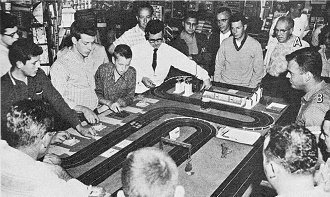
High excitement at Rich's Hobbytowne in Parsippany, N.J., for
finals in 2-state competition. AM's Howard McEntee (A) and Rich Palmer (B) observe.
Aurora track and equipment.
"Race Cars in Your Living Room" in the previous issue gave background details
on the rapidly expanding field of model electric cars. Now let's examine more closely
the cars themselves, the tracks and accessories. The prospective buyer's first step
is to consider what he wishes to get from the car outfit. Is it to be added to an
existing model train layout? If this is the case, you can pick a make that closely
matches your train scale, no matter what the latter may be.
As we've noted, "scale" is a tricky matter, and the car makers aren't always
in agreement on their terminology. Thus we find cars supposed to match HO trains
in scale size rated in various ways, the most common being simply to HO scale. But
the Aurora cars correctly listed as "HO scale" measure only about 1 7/8" long. Minic
Motorways cars also said to be in HO scale are listed "1:80 scale," their smallest
cars measure 2 13/16" in length. The English Wrenn vehicles, labeled 1/52 scale,
are under 3" long. So you had better take your ruler (for a good understanding of
this scale matter see A. M. for July, 1961, page 28) when you go shopping.
If you enjoy "customizing" cars, the larger sizes may be of more interest; you
can add details to them more easily. Some of these come in kits, which the do-it-yourself
hobbyist may prefer. The two Strombecker lines (1/32 and 1/24 scale) are in this
category. So are the Hawk and Lindberg models - see table.
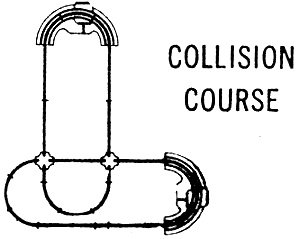
Typical ITC Model Craft layout is not for the faint hearted!
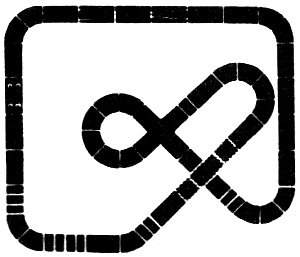
Scalextric course above demands steady hand on the tight corners.
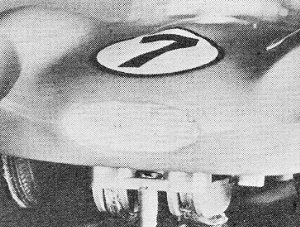
Strombecker car close-up shows how contact is made between car
and "hot" section of track.
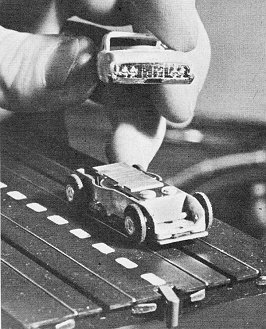
Aurora's unique motor car is true "HO" scale.
Should your preference run to competitive racing, you should consider the space
you have available to set up a track. To put together a really extensive race track
for the larger cars you will need quite a lot of area. Just because they are tiny,
don't think the "HO scale" systems can't be used for real racing! We examined a
very comprehensive 4-track racing layout with four hair-pin turns, six right angles
and a long straightaway constructed on an area less than that of a ping pong table
top - and it is a raceway that taxes the skill of the most accomplished driver.
The track, set up at Rich's Hobbytowne (Parsippany, N.J.), is used for a regular
schedule of races by a large and enthusiastic group of youngsters.
Some modelers make a real effort to keep the length of each lane exactly the
same, when they set up such a track. This insures that each car will travel the
same distance. Actually, this is not quite as important as you might suspect; the
cars on the "outside" most of the time will have larger radius turns and can go
through the turns faster...and with less danger of "spinning out."
Some makes offer much more in the line of accessories than others, and if you
go for scenic effects, better check the catalogs to see what is available.
To give an idea of sizes of tracks of various makes, we include a sketch showing
typical cross sections. Note that one make of car usually cannot operate on another
manufacturer's track. Some can be switched about - it depends upon power system,
pickup strips and slot size. Your hobby dealer can help you in this.
Some makes offer facilities for adding more lanes to the basic track. Most track
sections carry two lanes; the larger ITC has one. Scalextric makes sections so that
you can assemble road-ways of up to six lanes which allow six cars to make a genuine
Le Mans start. This outfit does not use a rigid plastic material for the track -
theirs is more flexible and rubbery; it should prove practically unbreakable.
Some lines include junctions (also called "turn-offs"...they operate like switches
on model railroads). A.C. Gilbert has a tricky 6-switch T-section, for example.
While cross-overs are quite common, most unusual one is a "scissors" from ITC, which
can be adjusted to vary the angular difference between the crossing tracks. Quite
a few makes have bridges of one sort or another; with these, you can make a figure
eight without a crossover, or add other hazards or points of realism in your layout.
Most bridges use normal straight and flat track sections up and over the hump, so
the car must be slowed to negotiate the rather abrupt angular changes. Minic Motorways
has curved sections for bridges (as viewed from the side) so transition from flat
track up over the bridge and back down is smooth. While it wouldn't do to put it
in the midst of a racetrack, this same line also has a "traffic circle" for inclusion
in a model highway system.
You can get an automatic lap counter in one line (Eldon) to reduce arguments
as to "how many laps still to go." The A.C. Gilbert track is unusual in that besides
two standard current pickup strips there is a third in the track guide slot; this
makes it possible to drive two cars on the same lane, each under independent control.
The Wrenn (English) line has sections which allow a car to be shifted from one lane
to another at will. These operate by pressing a button on the special section, remote
control may be offered later.
Most cars have a pair of pickup contact springs on the underside, that press
down against two matching metal strips in the track. The springs must be strong
enough to make good contact. In some of the smallest cars these springs lift the
front wheels off the track so they never turn. Triang Minic cars have an unusual
pickup, a double sided metal wheel with insulation between the sides. As the wheel
rides in the track slot guiding the car, its metal halves pick up power from strips
mounted vertically on each side of the slot. The pick-up wheel must revolve, of
course, since the front weight of the car rests on it, and it is also mounted to
turn sideways, so it can follow the slot in curves. The makers call the mounting
a "gimbal ring"; it was adapted and miniaturized from a similar unit used on early
Scalextric cars. The latter now has a more conventional guide pin, plus a pair of
sprung pickup shoes.
Speaking of guide pins - and all these cars must have a pin or something to keep
them in their track - Minic has a cute trick in this line. Normally the guide pins
(or the pick-up wheel, on Minic cars) are at the front, and they swing the car around
a turn very neatly, as the car travels forward. But what happens if you should want
to back up - you would seldom wish reverse movement with racers, but for city roadways
you might? With that pin in the slot at one end of the car and the drive wheels
on the other end, the car would soon be crossways, with no drive power. Minic cars
have a slot in the rear of the chassis for a Reversing Peg; snap one in the chassis
and you have guides at each end of the vehicle - and it will go backward just as
well as forward. Since Minic makes several styles of busses, users would probably
fit the peg to these in any case, since you certainly wouldn't want your bus to
"drift" around a sharp bend!
The "expert" hobbyists haven't decided among themselves whether a race car does
better with full steerable front wheels or not. Some home built cars are so fitted
these days, some aren't. Steerable front wheels add quite a bit of complication
- which means higher cost in manufactured cars - but there is no doubt that they
look more realistic in operation. In the makes examined we find only two with this
feature. The Gilbert cars have the front wheels pivoted "buggy-style," they pivot
as though they were on a solid axle with a center pin. They do turn, though, and
are controlled by a double slot pin, so these cars actually steer through a turn
instead of skidding.
Only one make uses true Ackerman steering, such as you find on autos. The larger
Strombecker cars have it as an option, the assembly being combined with a current
pickup unit, these parts being used to convert the non-operating 1/24th scale cars
for running on Strombecker track. Two motors have also been used in the Strombecker
line, a light duty 3 volt type and a more potent unit with carbon brushes that works
on higher voltage.

Chart provides
rundown on most slot car track types.
Speaking of motors, there is quite a wide variety in use. A few makes use 5-pole
armature model train-type motors (Gilbert and Scalextric, for example). Most others
use 3-pole motors of various types. As you'll note from the Specifications chart,
several makes operate on low voltage - 1 1/2 to 3 volts - but most run from 6 to
12 volts. Batteries can be used to run any of these motors, but power packs generally
are more practical if a lot of running is to be done. Since practically all the
motors require DC (Aurora and Wrenn exceptions - they will run nicely on either
AC or DC) small model train power packs with built-in rectifiers serve admirably.
By now your hobby shop should be able to supply missing data.
All motors except the last two employ a conventional rotating armature. Aurora
and Wrenn use vibrator motors; they have a magnet coil, adjacent to which is a vibrating
armature that controls a pair of contacts which are normally closed. When power
is turned on the armature is attracted to the magnet, this opens the circuit. The
armature thus vibrates like that on a door buzzer. Attached near the free end is
a flat spring that engages teeth on a ratchet gear which is part of the rear axle.
As the armature moves up and down the ratchet gear turns the wheels.
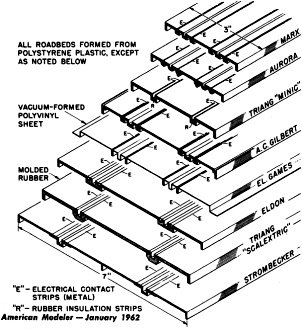
Representative slot car track sizes.
The Marx cars will be driven by a jewel-like PM motor with carbon brushes. Racing
enthusiasts are waiting to try these against the vibrator-motor Auroras, a contest
that appears quite feasible, since the slot size and power strip arrangements are
almost identical (track sections of the two lines won't mate due to different end
arrangements).
Before we leave cars, it should be emphasized that there is a great variety of
types. The majority are racers, and that's all you find in some lines. But some
concerns offer trucks, buses, Go-Karts...you can even get an Allis-Chalmers farm
tractor (from Strombecker).
Among the accessories are power packs and controllers. Most of the packs have
no speed control lever on them (as you find on some model train packs) since you
want to control the operation of two or more cars individually on their separate
lanes. Various arrangements are offered for this; simplest are push buttons - hold
the button down and the car goes (wide open) let it up and power is cut off. This
is not as crude as it sounds, some of the hottest drivers prefer such control; to
send the car along at less than full speed they "pulse" the button "on" and "off"
rapidly. Short on pulses give slower speeds, to increase it you lengthen the on-time
and shorten the off. Several makers offer variable control units; that by Scalextric
is held in the hand, and is normally off. The harder you press a thumb slide, the
faster the car goes. The Gilbert controller to be fastened to the table top has
a lever at the side looking something like an accelerator pedal (you put it back
and forth with your hand). The Aurora controller, is also a table-top deal, has
a hand wheel to vary the car speed. Eldon offers rheostat control.
While we've said a lot about special types of track, it shouldn't be overlooked
that several makers offer cars which don't need special track, a couple more don't
use any track at all. The first type run on standard HO train track. The Lionel
car is a double worm drive job (all four wheels driven). The Atlas unit is moved
at a fast clip by an air prop. For those who have HO trains these allow one to try
something much different for a change (they can also be had in complete sets). The
"no-track" car is by Hawk - actually it does use a guide, a length of string. Hawk
cars come in kit form only, are fairly large size and thus good for "customizing,"
carry batteries internally for power. Hawk has worked out an arrangement whereby
several of their cars may be started simultaneously in a true drag race. The Lindberg
cars which come only as kits, use a length of plastic tubing as a guide. They carry
their power internally, are packed two in a set, with a 36' length of tubing.
You must agree, there is a surprising variety of model electric car equipment
on the market. By the time you've read this, we imagine there will be even more!
Posted January 22, 2024
(updated from original
post on 1/17/2014)
|


